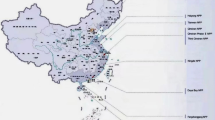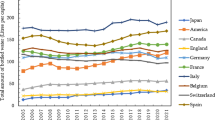Abstract
Tritium concentration was monitored in different water sources collected around Kaiga Nuclear Power plant, India. The concentration was in the ranges < 1.9–27.4 Bq L−1 (GM = 4.0 Bq L−1) for groundwater, < 1.9–42.1 Bq L−1 (GM = 3.5 Bq L−1) for surface water and in 12.4–42.0 Bq L−1 (GM = 24.07 Bq L−1) for reservoir water. The concentration values observed in this study are similar to those reported for other PHWR stations of the world. The radiation dose to the public due to ingestion of Tritium through groundwater was computed to be 0.08 μSvy−1.






Similar content being viewed by others
References
Catalano R, Imme G, Mangano G, Morelli D, Giammanco S (2014) Natural Tritium determination in groundwater on Mt. Etna (Sicily, Italy). J Radioannal Nucl Chem 299:861–866
Greg J (2008) Tritium issues in commercial pressurized water reactors. Fusion Sci Technol 54:329–332
Health Physics Society-Specialists in Radiation Safety Report. http://hps.org/documents/Tritium_fact_sheet.pdf. Accessed 22 Feb 2018
Nikolov J, Todorovic N, Jankovic M, Vostiner M, Bikit I, Veskovic M (2013) Different methods for Tritium determination in surface water by LSC. Appl RadiatIsot 71:51–56
Thompson PA, Kwamena NOA, Ilin M, Wilk M, Clark ID (2014) Levels of Tritium in soils and vegetation near Canadian nuclear facilities releasing Tritium to the atmosphere: implications for environmental models. J Environ Radioact 140:105–113
Atomic Energy Regulatory Board, Annual Reports (2017). https://aerb.gov.in/images/PDF/Annual_report/ar2017/annrpt2k17.pdf. Accessed 21 March 2019
Karunakara N, Somashekarappa HM, Narayana Y, Avadhani DN, Mahesh HM, Sidappa K (2003) 226Ra, 40K and 7Be activity concentration in plants in the environment of Kaiga, India. J Environ Radioact 65:255–266
Hegde AG, Varma PC, Rao DD (2008) Bhabha Atomic Research Center (BARC) Standard protocol for evaluation of environmental transfer factors around NPP sites. https://www.osti.gov/etdeweb/servlets/purl/21134202. Accessed 21 Nov 2014
Nayak RS, D’souza RS, Kamath SS, Mohan MP, Bharath S, Trilochana S, Sudeep KK, Narayana B, Dileep BN, Ravi PM, Karunakara N (2019) Organically bound Tritium: optimization of measurements in environmental matrices by combustion method and liquid scintillation spectrometry. J RadioannalNucl Chem. https://doi.org/10.1007/s10967-018-6395-y
Mohan MP, D’souza RS, Nayak RS, Kamath SS, Trilochana S, Sudeep KK, Yashodhara I, Mayya YS, Karunakara N (2018) A study of temporal variations of 7Be and 210Pb concentrations and their correlations with rainfall and other parameters in the South West Coast of India. J Environ Radioact 192:194–207
Chang KK, Byung HR, Kun JL (1998) Environmental Tritium in the areas adjacent to Wolsong nuclear power plant. J Environ Radioact 41:217–231
Baeza A, Garcia E, Parianez R (2005) Modelling the spatio-temporal evolution of Tritium in the waters of the River Tagus. J Environ Radioact 86:367–383
Paunescu N, CotarleaM GaleriuD, MargineanuR Mocanu N (1999) Evaluation of environmental Tritium level in preoperational period of Cernavoda CANDU Nuclear Power Plant. J RadioannalNucl Chem 239:465–470
Miljevich N, Sipka V, Zujic A, Golobocanin D (2008) Tritium around the Vinca Institute of Nuclear Sciences. J Environ Radioact 48:303–315
Results of environmental monitoring programs, Ontario power generation Inc, N-REP-03443-10013. http://www.opg.com/news-and-media/Reports/2013_EMP_Report.pdf. Accessed 22 Feb 2018
Bolsunovskii A, Bondareva LG (2005) Tritium in water bodies of the Yenisei basin in the impact zone of the mining-and-chemical plant of the ministry of the nuclear power industry of the Russian Federation. Russ J Ecol 36:52–56
Tonosaki K, Kudoh H, Kimura H (2000) Tritium concentrations of natural waters in Rokkasho-mura. J RadioannalNucl Chem 243:579–585
Valgma I, Torn H, Erg K (2006) The impact of infiltration dam on the groundwater regime in the kurtna landscape reserve area. Oil Shale 23:3–14
Dingwell S, Mills CE, Phan N, Taylor K, Boreham DR (2011) Human health and the biological effects of Tritium in drinking water: prudent policy through science—addressing the ODWAC new recommendation. International Dose Response Society 9:6–31
The International Commission on Radiological Protection (2007). Compendium of Dose coefficients based on ICRP Publication 60. Annals of ICRP. http://www.icrp.org/docs/P%20119%20JAICRP%2041(s)%20Compendium%20of%20Dose%20Coefficients%20based%20on%20ICRP%20Publication%2060.pdf. Accessed 31 Aug 2019
World Health Organization (2011) Guidelines for drinking-water quality, WHO Library Cataloguing-in-Publication Data NLM classification: WA 675. https://apublica.org/wp-content/uploads/2014/03/Guidelines-OMS-2011.pdf. Accessed 21 March 2019
The International Commission on Radiological Protection (2007) The 2007 Recommendations of the International Commission on Radiological Protection. Annals of the ICRP-103 http://www.icrp.org/docs/ICRP_Publication_103-Annals_of_the_ICRP_37(2-4)-Free_extract.pdf. Accessed 21 March 2019
Acknowledgements
The authors would like to thank the Board of Research in Nuclear Science (BRNS), Department of Atomic Energy, Government of India, for funding the research programme. The authors would also like to thank the Site Director and other officials of ESL, Kaiga Generating Station, Nuclear Power Corporation of India Ltd., for supporting this research programme. The help received from Mr. S. S. Managhanvi and his colleagues, Health Physics Unit, Kaiga Generating Station, Kaiga, during the sample collection is gratefully acknowledged.
Author information
Authors and Affiliations
Corresponding author
Ethics declarations
Conflict of interest
There is no conflict of interest of the work reported in this article with any other agencies.
Additional information
Publisher's Note
Springer Nature remains neutral with regard to jurisdictional claims in published maps and institutional affiliations.
Rights and permissions
About this article
Cite this article
Kamath, S.S., Narayana, B., D’Souza, R.S. et al. Tritium in water bodies around the Kaiga generating station. J Radioanal Nucl Chem 322, 389–397 (2019). https://doi.org/10.1007/s10967-019-06742-z
Received:
Published:
Issue Date:
DOI: https://doi.org/10.1007/s10967-019-06742-z




